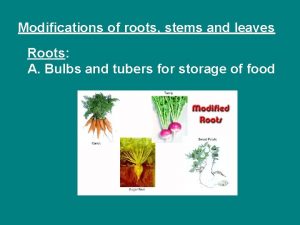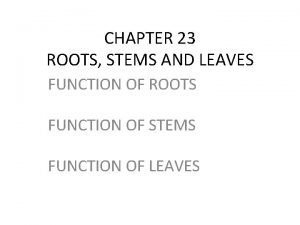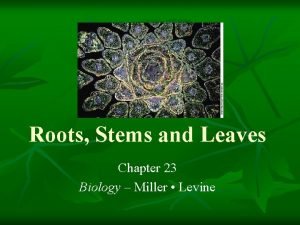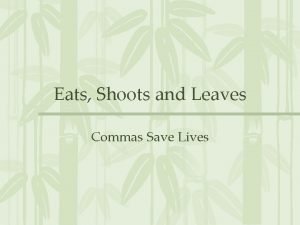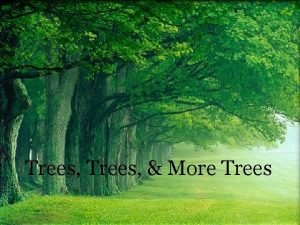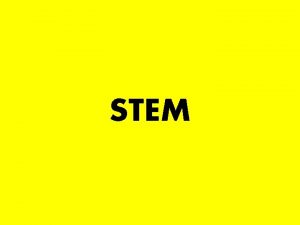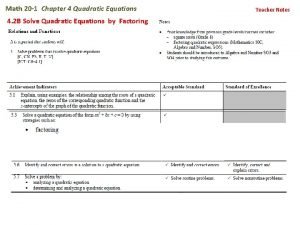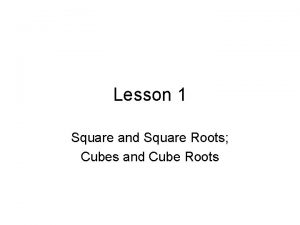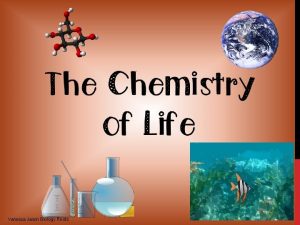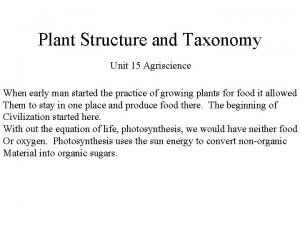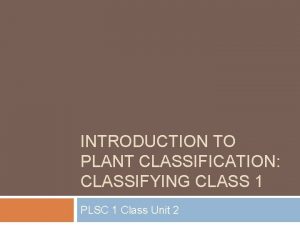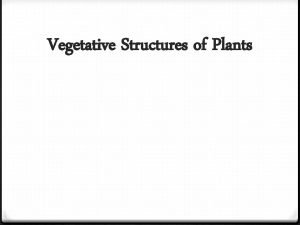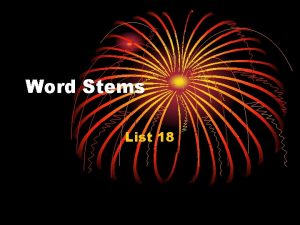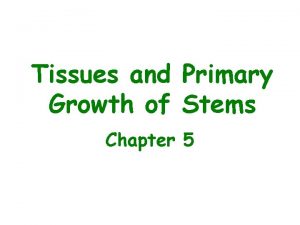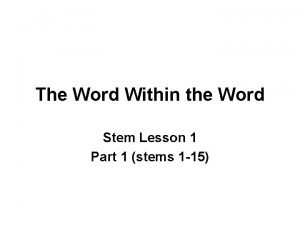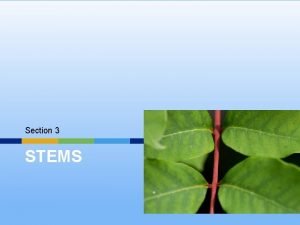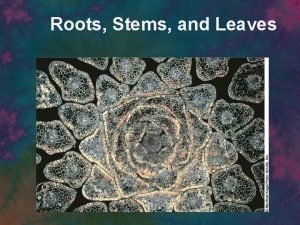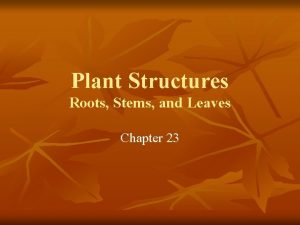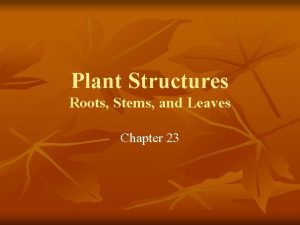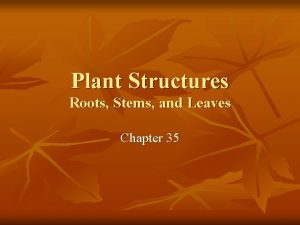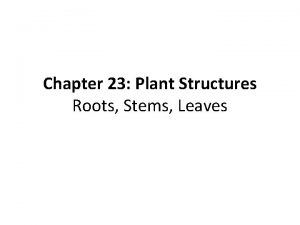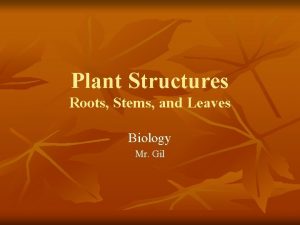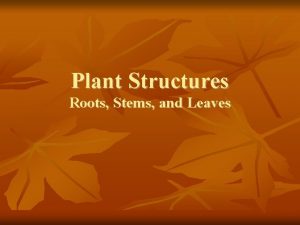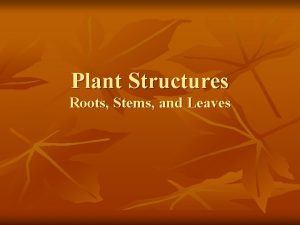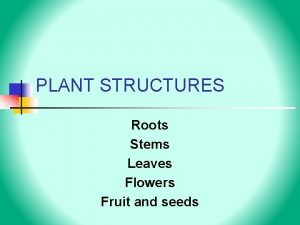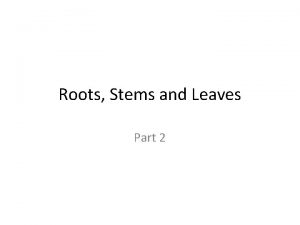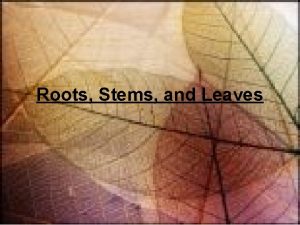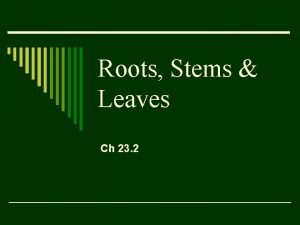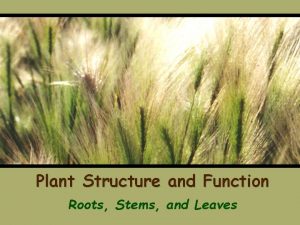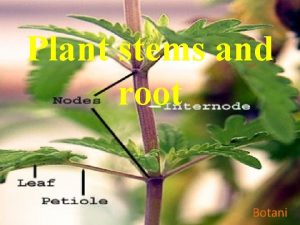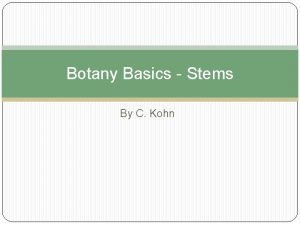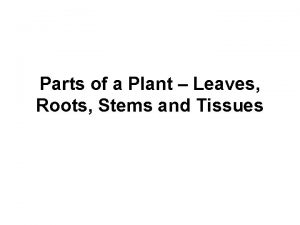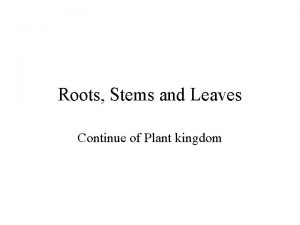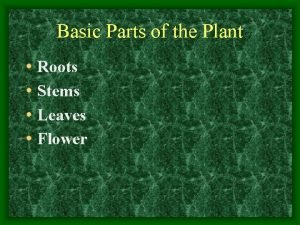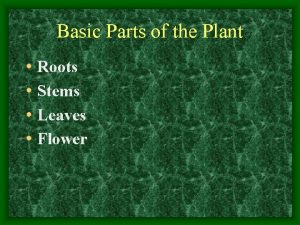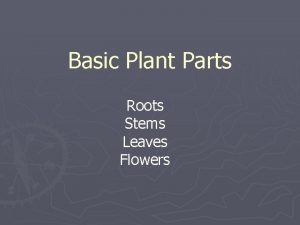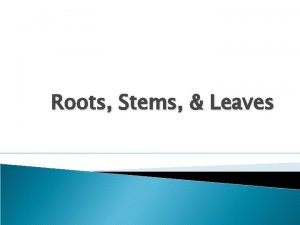Plant Structures Roots Stems and Leaves Chapter 23































- Slides: 31

Plant Structures Roots, Stems, and Leaves Chapter 23

Plants n Seed plants have three main structures: Roots n Stems n Leaves n n Linked together by various means

Function of Roots n n Absorb/Transport water and nutrients Anchor plant to the ground Hold soil in place and prevent erosion n Storage of sugars made In photosynthesis n

Functions of Stems n n Support for the plant body Carries nutrients throughout plant

Functions of Leaves n n Main photosynthetic systems Sight of gas exchange

Tissues in Plants 1. 2. 3. Dermal tissue Vascular tissue Ground tissue

Tissues in Plants 1. Dermal Tissue n Outer covering n Cuticle n n Roots have dermal tissue n n – waxy coating Root hairs Stomata and Guard cells within

n Tissues in Plants V for vascular, V for vein! 2. Vascular Tissue Transport System Carries water and nutrients. n n Xylem n n (Water in) Phloem n (Glucose out)

Tissues in Plants n 3. Ground Tissue n Cells between dermal and vascular tissue

*Roots n Types of Roots Taproots n n n Long, thick root Reach deep into the soil to obtain water/nutrients Fibrous roots n n Many thin roots Spread out away from plants to find water and nutrients quickly Helps to reduce erosion of soil Taproot Fibrous root

n Roots Root Functions Anchor plant n Absorb water/nutrients n Storage of sugar n

Stems n Functions Produce leaves, branches, and flowers n Hold leaves up n Transport substance between roots and leaves

Stems n 2 types of stems 1. 2. Herbaceous Woody

Stems n Xylem and phloem Transport water and nutrients n Contain nodes n – attachment for leaves

Leaves n Function n Main site of: n n Photosynthesis Covered by: n epidermis and cuticle n Create water proof barrier

Leaves n Mesophyll (meso=middle) 1. Palisade mesophyll -site of most photosynthesis 2. Spongy mesophyll -some photosynthesis

Leaves n Stomata n n n – pores in the underside of the leaf Gas exchange n CO 2 in n O 2 out Guard Cells – Surround the stomata n Open and closes stomata ***Stomata closed at night to prevent H 2 O loss

Leaves n Transpiration n n Loss of water through its leaves Replaced by water drawn into the leaf

Transport in Leaves n Vein (Vascular Tissue) n Xylem n n “Water in” for photosynthesis Phloem n “Glucose out” after photosynthesis

Tropisms Growing toward or away from a stimulus Phototropism Stimulus = Light Thigmotropism Stimulus = Touch Leaves have positive phototropism Vines have positive thigmotropism

Tropisms Growing toward or away from a stimulus Gravitropism Stimulus = Gravity Roots have positive gravitropism Hydrotropism Stimulus = Water Roots have positive hydrotropism


Plant Adaptations

Types of Adaptations n n Structural adaptations are the way something is built or made. Behavioral adaptations are the way something acts naturally or by instinct.

Behavioral Adaptations n Adaptations to get food n Plants like the Venus fly trap, trap insects for food.

Behavioral Adaptations n Adaptations for reproduction n Plants drop seeds to grow new offspring.

Structural Adaptations n Adaptations to get water and nutrients n Roots soak up water and nutrients from soil.

Structural Adaptations n Adaptations for defense n Spines and thorns protect plants from predators

Structural Adaptations n Adaptations for defense n Poison Ivy and Poison oak have toxins that give predators a painful itchy rash.

Desert Adaptations n Small leaves or spines on desert plants conserve water. Thick waxy skin holds in water. n Roots near the soils surface soak up rain water quickly before it evaporates. n

Rainforest Adaptations n n Smooth, slippery bark keeps vines from killing trees. Slide shaped leaves lets rain run off so fungus doesn’t grow on plants.
 Plant modifications of roots stems and leaves
Plant modifications of roots stems and leaves Leaf structure cube
Leaf structure cube Chapter 23 roots stems and leaves
Chapter 23 roots stems and leaves Lesson 3 existence and uniqueness
Lesson 3 existence and uniqueness Save the comma
Save the comma Living things that have leaves and roots
Living things that have leaves and roots Leaves branches trunk and roots song
Leaves branches trunk and roots song Types of stems
Types of stems Jaringan
Jaringan Roots part i
Roots part i Quadratic equations with fractions
Quadratic equations with fractions Is 72 a perfect square
Is 72 a perfect square Vanessa jason biology roots
Vanessa jason biology roots The roots of american imperialism 1. economic roots
The roots of american imperialism 1. economic roots Homologous
Homologous Phyllid
Phyllid Internal structure of a leaf diagram
Internal structure of a leaf diagram Unit 15 plant structures and taxonomy
Unit 15 plant structures and taxonomy Plant
Plant Tronsmo plant pathology and plant diseases download
Tronsmo plant pathology and plant diseases download Tronsmo plant pathology and plant diseases download
Tronsmo plant pathology and plant diseases download Tronsmo plant pathology and plant diseases download
Tronsmo plant pathology and plant diseases download Parts of roots
Parts of roots Scope of plant breeding
Scope of plant breeding Taichum
Taichum Plant introduction in plant breeding
Plant introduction in plant breeding Vapor definition
Vapor definition Cork cambium
Cork cambium Lesson 1
Lesson 1 Tree epidermis
Tree epidermis Functions of the stem
Functions of the stem Sat question stems
Sat question stems
